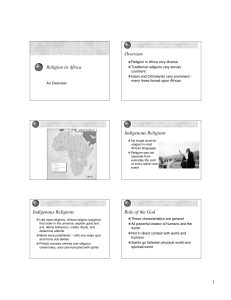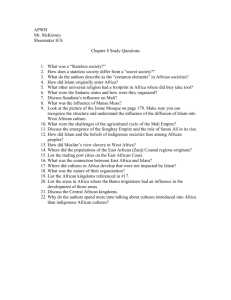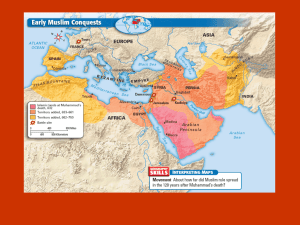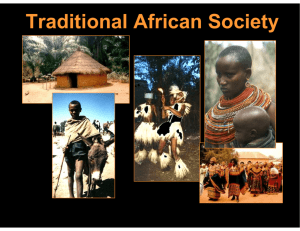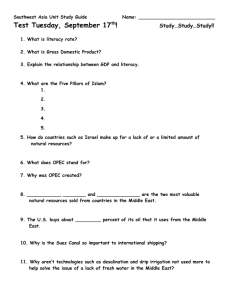Animism
advertisement
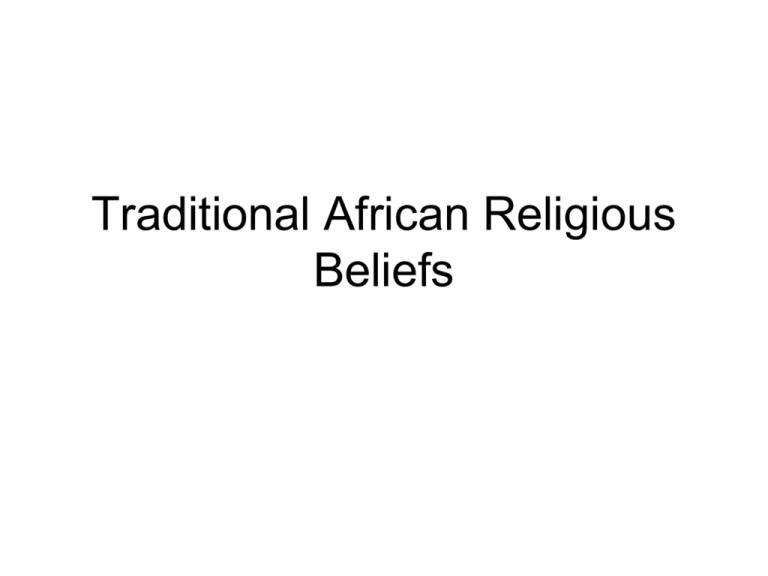
Traditional African Religious Beliefs Role of Religion in Africa African Religions • “African Traditional Religions” = indigenous religions • Islam = introduced to sub-Saharan Africa in 11th c. • Christianity = introduced to West Africa in 15th c. • Folk Christian Groups = indigenous Christian movements since early 1900’s Africa Religions • In Africa the three major religions are Traditional Beliefs, Christianity, and Islam. • Traditional beliefs may include worship of: – ancestors, – spirits, – gods, – animals, – land, – inanimate objects, – and/or natural phenomena. Traditional Religions of Africa • Not able to speak with authority about a single religion, theology, or ritual system. • Few written records; oral tradition passed on by griots (singing, story tellers). • The religious beliefs and customs of one group are not universally shared by others. • Great variety of beliefs and practices in African tradition Animism • Before the introduction of Islam and Christianity, Africa had a very developed system of religion. • It was called Animism, which cannot be minimized to a specific set of beliefs, but most ethnic groups believed in: • • • • • One supreme god Several other gods Belief in spirits of ancestors Sacrifice (child or animal) to secure protection Need to undergo a Rite of Passage which is a “coming of age” ceremony or ritual Animism • Traditional African people developed belief systems that helped them understand and organize information about their world. • Developed throughout many parts of the world throughout the course of history Characteristics of Sub-Saharan Africa Sub-Saharan Africans are often polytheistic and worship many gods Characteristics of Sub-Saharan Africa They practice Animism: a religion in which spirits exist in nature and play a role in daily life Traditional Religion and Culture Many early Africans shared similar religious beliefs and shared common features in the arts as well. Examples of Beliefs Animism • Many believed that unseen spirits of ancestors stayed near • Many Africans also practiced form of religion called animism—belief that bodies of water, animals, trees, other natural objects have spirits • To honor spirits, families marked certain places as sacred places, put specially carved statues there • Families gathered to share news, food with ancestors, hoping spirits would protect them • Animism reflected Africans’ close ties to natural world African Animism Traditional African Religion ANIMISM 1. Belief in one remote Supreme Being. 2. A world of spirits (good & bad) in all things. 3. Ancestor veneration. 4. Belief in magic, charms, and fetishes. 5. Diviner mediator between the tribe and God. Religion • Animism the belief that spirits are present in natural objects – Many Africans believed the spirits of their departed ancestors were present on Earth – Ancestral spirits would be called upon for help in times of need/trouble What animals is portrayed by the apparel in the photo? Animism • To some animists, objects do not actually possess spirits, but are valued because they have a potency to serve as a link between people and the omnipresent god • Animism can be a very complex belief system • Sub-Saharan Africa is the greatest surviving stronghold of animism – Along the north edge Islam is rapidly winning converts – Christian missionaries are very active throughout the area Animism • Retained tribal ethnic religion of people around the world • Today, adherents number at least 100 million • Animists believe certain inanimate objects possess spirits or souls – Spirits live in rocks, rivers, mountain peaks, and heavenly bodies – Each tribe has its own characteristic form of animism • A Shaman — tribal religious figure usually serves as the intermediary between people and the spirits Animists Populations • The largest population of Animists today is in Sub-Sahara Africa. • Animists still exist in Native American tribes in North and South America. • Aborigines in Australia are also considered Animists. Beliefs in Supreme Beings, Spirits, and Divinities High God and Lesser Spirits Animistic Gods • Animistic Gods are often immortalized by mythology explaining the creation of fire, wind, water, man, animals and other natural earthly things. • Each sect of animism varies, but there are similarities between gods, goddesses, and rituals. • There are holy men or women, visions, trancing , dancing, sacred items, sacred places for worship and the connection felt to the spirits of the ancestors. The High God • Belief in a Supreme High God who created the world and then withdrew from active participation in it is common in polytheistic religions around the world • Belief shared by many African people • Most African religions are polytheistic in day-to-day practice • Beyond all minor gods, goddesses, spirits and ancestors, exists one High God, who created and in some sense still governs the universe. High God Continued • Most believe that this God is too distant and has limited contact with daily operation of human life • Can be appealed to in times of great crisis • Yoruba tribe of West Africa – Olorun (High God) – He assigned creation to his eldest son Obatala, who failed to complete the task. Olorun passed it on to Odudua, but he failed too. Olorun oversaw creation himself by assigning smaller tasks to various orisha, lesser deities. Olorun then retired to the heavens and has little contact with people. Nuer Tribe of Sudan: Exception with the High God • Kwoth Nhial (High God) continues to play an active role in the lives of humans • He rewards the just, punishes the wicked, and blesses those who uphold the moral values of the Nuer people • He loves and cares for His creation and is asked for blessing and assistance High God • Most Africans believe the High God is too powerful to be appealed to for daily problems. • He really isn’t interested. • Lesser deities or orishas control day-today occurrences • Even Nuer have a host of lesser deities The Lesser Spirits abilities of supreme being (creation), aspects of nature (water), historical humans (leaders), human activities (agriculture) celebrate through myth, song, prayer, sacrifice, possession, gendered, character, food, color, altars, images, priests, rituals, daily relationships The Lesser Spirits • Earth, water, and sky contain spiritual life similar to human kind • Mountains, forest, rivers and streams, many plants and animals • Storms, lightening, thunder • Spirits can be beneficial or harmful • They are influenced by prayer, flattery, and sacrifice. • They have a direct influence on human life so Africans seek to understand them and seek their favor World of the Spirits Dogon “Spirit House” Lesser Spirits Continued • • • • • • • • They can be male or female. Earth is regarded as a mother goddess. Ex. Ashanti prayer for the Earth Mother: “Earth, while I am yet alive, It is upon you that I put my trust Earth who receives my body, We are addressing you, And you will understand.” • In Ghana there is a water spirit called Mami Water • The fishermen consider her so sacred they do not talk about her openly. People believed they had to maintain a favorable (good) relationship with the spirits or else suffer their wrath (anger). Water: A Sacred Element • Water sacred to many cultures. • When life depends on water in the form of rainfall, rivers, and streams, water takes on a life of its own. • Africans use water for rituals such as the washing of the newborn and the dead. • It must come from a source of sacred, living water. • It must not be heated or boiled, or treated with chemicals as that would kill the spirit in it. Ouidah, Benin Mamy Wata, the goddess of the Sea. Mountain God • Sacred Mount Lengai is in Kenya’s crater highlands, a region populated by Maasai pastoralists. • Their main god Lengai is benevolent as the black god of rain and evil as the red god of the sun. Mountain God • Ol Doinyo Lengai, meaning “Mountain of God,” last erupted with a plume of ash in 1982 • Maasi pilgrimage here to pray for rain, cattle, and children. Ancestor Worship Ancestor Worship • Most commonly recognized spiritual forces in Africa • Continue to live on in the spirit world and unlike the High God take an active interest in the wellbeing of those who live in the world. • Ancestors are consulted before the birth of a child, beginning of an agricultural season, prior to battle, or political conflicts. • In some tribes, no one may eat the first fruit of the harvest until it has been offered to the ancestors. Ancestor Worship Continued • While in China and Japan ancestors are loved and respected, in Africa they are feared. • They can be capricious (do whatever they want, fickle) and unpredictable. • Ancestors can do whatever they want. • Despite many offerings, they can turn on you or the community. • May cause sickness, death, childlessness (a major curse) • Ancestors more than the gods are the enforcers of the moral codes of the tribe. Ancestor Worship Continued • Gifts and sacrifices offered to them • Belief that ancestors own the land and its products • Portion of harvest must be offered to them • When animals are born, some must be slaughtered and offered to ancestors to ensure their blessings. • Modern Africans living in cities, return to their native villages to offer sacrifices Religious Leaders under Animism Religious Leaders in Traditional African Religions • Not a major need for religious leaders; many activities can be performed by individuals – offerings of food and drinks to ancestors • No complex theology or rituals like in Hinduism, Judaism, or Christianity • No requirement of a priesthood and temples are very rare • Some communities in West Africa do have temples and altars; people trained in African mythology, taboos, and rituals to prepare them Religious Leaders • Shaman – Medicine man or woman – Conducts ceremonies Religious Leaders • Diviners: • Served as interpreters • Job was to explain misfortune Religious Leaders • Healers – Helped families become aware of problems, along with providing remedies North American Shaman West African Griot Animism • Medicine Man Role of Rituals and Diviners Diviners and Healers Diviners and Healers • Rooted in Tradition • Their purpose was to explain the cause of misfortune • Experts in herbal medicine • Today, doctors study the roots and herbs used in traditional African healing Diviners: Communication with Ancestors • They can speak to you in dreams • They can send signs to you in nature that can be interpreted with the help of diviners, spiritual specialists • Signs are sometimes interpreted by looking at the organs of sacrificed animals • Diviners can also contact ancestors for help with knowing the future. Diviners • Causes: natural & supernatural; humanhuman, human-divine, & human-natural relationships are messed up • Divination: ritual process, humans obtain inaccessible, obscure info. about a client’s place in religious cosmos – Priests handle neutral objects – Priests interpret meaning of results (i.e. Yoruba Ifa diviners & Orunmila & Odu, 16 palm nuts, x8 times, 256 chapters) African Diviner (Shaman) Tallensi Tribe: Example of Pleasing Ancestors • Tallensi man named Pu-eng-yii left his family and settled with a rival group to earn more money. • Auto accident, serious leg injury • Diviner told him that ancestors were angry; told him that his ancestors had intended to kill him but failed to follow through on the plan. • Solution: He had to make restitution (monetary compensation) for leaving his family, severe ties with newly adopted family, and return home. Sacrifices Sacrifices to Please Spirits and Ancestors • Pouring our a bit of their drinks or tossing away bits of their food (similar to when you drop a hot dog at a BBQ – an offering to the backyard gods). • Simple act that pleases spirits and ancestors • Sacrifice of animals for more serious occasions – dogs, birds, sheep, goats and cattle Animal Sacrifice and Other Sacrifice to Appease Gods • Blood poured out on ground or altar • Before a battle or election campaign or when there’s a serious drought or in times of illness • Prior to engaging in a dangerous hunt • Ogun – Yoruba god of iron. In modern day, he is a god of machinery. • People who drive automobiles in dangerous streets decorate their cars with his symbols Partaking in the Sacrifice: Communion with Spirits • After animal is sacrificed, a portion is cut and roasted or boiled and offered to the deity. • A portion is consumed by those in the sacrifice. • This unites them with the spirits. • A long tradition with world religions to build spiritual bond • Consider Christianity and Holy Communion Rituals and Rites of Passage Places of Worship • Rituals take place outdoors in nature Ritual • Organized group activity • Relationships among humans, superhumans & nature give meaning to ritual • Rites of passage: define social, religious, physical identity (birth, puberty, marriage, death) Rituals and Rites of Passage • Important parts of life marked with rituals • Rites of passage regulated by religious functionaries • Birth of child – time for great rejoicing; great blessing from the world of the spirits • Twins – not a blessing, dangerous and evil. • Sometimes, regarded that women had two men and each were the fathers • Occasionally, one or both are killed Rituals and Rites of Passage continued • In many African societies, including the Ashanti, children are not named for the first week of life. • Because of high infant mortality, African tribes believe that it may be a trickster god who wants to trick people into loving it only to leave them • After they make it through a week, then much love is lavished on the child Rituals and Rites of Passage • After naming the child, there is a ceremony of gently throwing the child in the air and introducing it to the moon, which is deity (The Gu of the Benin) • The Basuto of South Africa say: “There is your father’s sister.” • Circumcision is sometimes done after child birth • Most of the time, it is reserved for puberty Circumcision • Circumcision is a religious requirement for Jews and Muslims and is significant to many Christians • For Africans, circumcision is reserved for when young men reach puberty • Severity can vary from a minor cuts that have no major threat to genital mutilation which can be life threatening • Usually no anesthetic Circumcision • The man who performs the ceremony may wear a mask representing the ancestors. • Represents passage into adulthood • Initiate is expected not to flinch or cry out in pain • Female circumcision is practiced in some African societies although there is growing opposition around the world • As with male circumcision, no major medical reason for doing it but supposed to control their erotic desire Rituals and Rites of Passage • Adulthood – responsibilities and privileges • Leaving the family home • Marriage is very important; so is bearing children; a childless couple will go to great lengths to discover why they are childless with the help of a diviner • Death – rituals to make the deceased comfortable; fear that their ghosts will return to haunt the living; widows fear that husbands will return to cause their wombs to die Marriage Rituals • Virginity is highly prized especially among young women • Some tribes sew part of the female genitalia when the girls are small for the future husband • Frequently, husband may not have sexual relations with wife while she is pregnant and nursing, which altogether may be two years. • Polygamy is practiced by elites of many traditional African tribes. Several wives and separate houses Rituals for the Dead • Africa’s warm climate ---dead buried quickly • Sometimes embalming and mummification; occasionally offered to hyenas • Burial with objects that will make their time in spirit world more enjoyable • In some African societies, illness, misfortune, death don’t just happen. Often the result of witchcraft or foul play • In past, dead were allowed to identify their killers. If their hands, dropped as they passed someone in the community or if they fell near someone as they were being carried, that person would have to defend his/her innocence. Death and World of Spirits • Most tribes do not have a system of eschatology or concepts of judgment and retribution after death. • Dead simply move into the world of the spirits and continue to be interested in the world of the living. • LoDagaa people of Ghana – exception • Crossing a river with a ferryman (similar to Greek idea of River Styx and Hades), easy if you were good, difficult and up to three years if you were bad, making up for your evil Islam and Christianity in Africa Other Religions in Africa ISLAM 25% * Nigeria largest sub-Saharan Muslim countries. CHRISTIANITY 20% • Religion • Indigenous religions tend to be animistic – The Introduction and Spread of Christianity • Entered northeast Africa around 300 A.D. – Coptic Christians - Ethiopia & Eritrea; other Christians in Sudan • Dutch brought Calvinism to South Africa in 1600s – The Introduction and Spread of Islam • Introduced about 1,000 years ago • Today, orthodox Islam prevails in most of the Sahel – Interaction Between Religious Traditions • Religious conflict most acute in northeastern Africa • Sudan: conflict between Muslims in north and NonMuslims in the south 72 Globalization & Diversity: Rowntree, Lewis, Price, Christianity in Africa The route of African Christianity • Egypt and Libya in the beginning • Apollos of Alexandria • Others from Cartage • Eunuch of Ethiopia, Meroitic Official, a.k.a. Kandaka, a Regent to the throne of Candace, the Queen of Ethiopia • Preservation of Scriptures in Africa, the Sinaiticus Texts particularly • Bishops such as Clement and Cyril, men of Alexandria in Egypt. • The Nubians of Sudan and the Coptic of Ethiopians are part of Africa Christians heritage. 4 Aksum churches Aksum became a kingdom based on Christianity Christianity in West Africa • Although Christianity was first introduced to Africa in Egypt in the 1st century, West Africa was not really exposed to Christianity until Europe colonized Africa • Traditionally, Europeans believed that Africans did not have a religious belief system (even though they practiced Animism) so many European churches sent missionaries to Africa to spread Christianity Christianity in West Africa • Some European countries used Christianity and the need for sending missionaries as justification, or another reason, for taking over land in West Africa • Today, Christianity is the most practiced religion in Africa Church in Nigeria • 2 billion adherents make it most practiced in the world. •Originated in Bethlehem (8-4 BC) and Jerusalem (AD 30) with Jesus Christ. • Spread by missionaries and the Roman Empire (Constantine A.D. 313). • It is the most practiced religion in Africa today. Christianity Syncretism in West Africa • Similar to the introduction of Islam in West Africa, people tried to fuse Christianity with Animism. • The mixing and fusion of two or more religions is called syncretism Islam in Africa Islam in West Africa Containment • Islam was introduced to West Africa through trading systems with Eastern and Northern Africa • North African people would trade horses, camels, fruits and salt for West African gold and food. • West African leaders forced Muslim merchants to stay outside of the cities so that their religion would not spread. EAST AFRICA Arab merchants brought their religion with them to East Africa Islam was introduced to the East African trade cities Islamic Mosque in Ghana WEST AFRICA AND ISLAM The gold-salt trade spread to the Northeast and attracted Muslim merchants Cultural diffusion between West Africans and the Muslims resulted Islam in West Africa • Along with adopting new practices and ethical values, West Africans kept some of their old religious practices. – Muslim leaders allowed them to continue religious traditions as long as they did not contradict (conflict with) the Five Pillars Faith. – W. Africans continued to show respect for the spirits of dead ancestors. They kept their belief in spirits who could help those or made sacrifices to them. – They used amulets, or charms, that they believed helped people or protected them from harm. The Spread of Islam in West Africa Traders Bring Islam to Ghana • Between 639 and 708 C.E., Arab Muslims conquered North Africa • They wanted to bring W. Africa into the Islamic world. • Initially the king of Ghana did not convert, nor did the majority of the people. • But the king did allow Muslims to build settlements within his empire theradiantlight.blogspot.com Islam in Mali • The tolerance shown by Muslims toward traditional religious practices helped Islam to spread. • Early leaders of Mali accepted Islam, but they didn’t follow all of its teachings. • In 1312, a new leader, Mansa Musa, took over in Mali. He became the first West African ruler to practice Islam devoutly. digitalhistory.uh.edu Islam in Mali • Under the rule of Mansa Musa, Mali became a major crossroad of the Islamic world. • Musa made a hajj, or pilgrimage to Mecca • His caravan was described as “a lavish display of power, wealth, and unprecedented by its size and pageantry.” • Included in his caravan was: – 500 slaves, each carrying a 6 lb. staff of gold – Caravan of 200 camels carrying • • 30,000 lbs. of gold Food, clothing, and supplies • Because of this impressive display, Mali gained acceptance as an important empire MANSA MUSA’S INFLUENCE Mansa Musa was a devout Muslim and went on a hajj to Mecca in 1324 Mansa Musa passed out gold nuggets to the people he met along the way of his long trip When Mansa Musa returned from Mecca, he was filled with religious fervor Djenne Mosque He built many mosques throughout the Mali Empire, including one at Timbuktu Islam in Songhai • • • • In the 1460s Sunni Ali became the new ruler of Songhai. He built a powerful army that enabled Songhai to break away from Mali and eventually conquer it. Early Songhai rulers didn’t seriously practice Islam Under the leadership of Askia Mohammed Toure, a devout Muslim, rigid controls were set to ensure Islam was being practiced properly. http://www.civilizacoesafricanas.blogspot.com EAST AFRICA The mix of African and Arab cultures led to the development of a new language: Swahili East African towns had mosques (Muslim places However, many Africans of worship) and were chose to keep their ruled by Muslim sultans traditional Animistic beliefs Changes in Africa due to Islam Change #1: Succession • • • An important change in government was in how people chose their next leader, or “line of succession” Traditionally succession to the throne had been matrilineal – the right to rule was traced through the woman’s side of the family After the arrival of Islam, succession became patrilineal – the right to rule went from father to son. http://www.zacstravaganza.blogspot.com Change #2: Structure of Gov’t • Muslims believed in a highly centralized government, which was different than traditional African society • After conversion to Islam, West African kings sought more control of local rulers • Rulers adopted titles used in Muslim lands, such as “emir” and “sultan” http://etudesafricaines.revues.org/docannexe/image/135/img-2small480.png Change #3: Adoption of Shari’ah Law • Customary laws of Africa usually: – were enforced by chiefs or kings – didn’t give physical punishments – Weren’t written down – Guilty person paid injured party with gifts or services – Family or clan of guilty person could also be punished http://www.onlinelegaltips.com/images/Judiciary-System-In-Africa.jpg Shari’ah Law: • Laws were written • Muslims believed that shari’ah came from God • Administered by judges called qadis – Cases were heard in a court • • http://shariahcouncil.org/ Witnesses called Ruled on basis of the law and the evidence presented Change # 4: Emphasis on Education • Muslims highly value learning & encouraged people to become educated. • Timbuktu – Became famous for its community of Islamic Scholars – Contained several universities – Schools were set up to educate children in the Qur’an • Schools run by an imam (scholar) • Basic subjects included studying the Qur’an, Islamic studies, law, and literature Change #5: Arabic: A New Language • In West Africa, Arabic became the language of religion, learning, commerce (business), and government. • Arabic became the language of TRADE and GOVERNMENT • West Africans continued to use their native languages in everyday speech. • Scholars used Arabic to begin to write about the history and culture of West Africa. • Arabic allowed rulers to keep records and to write to rulers in other countries. What was written about? • Described how people used animals, plants, and minerals to cure diseases. • Discussed ethical behavior for business and government. • Told how to use the stars to determine the seasons. • They recorded the history of the Songhai. • They wrote about Islamic Law Change #6: Architecture Mosques in West Africa Traditionally, West Africans built small shrines to the forces of nature. As they converted to Islam, they began to build mosques (Muslim house of worship). The mosques that were built blended Islamic architectural styles with their own traditional religious art. For example, the minaret (tower) of one mosque was designed to look like the symbol of a Songhai ancestor. • Mosques in West Africa used the materials that were available in the local area. Islamic Invasions Change# 7: Decorative Arts West Africans adopted the use of calligraphy and geometric patterns in their decorative arts. Arabic calligraphy was used to decorate costumes, fans, and even weapons. goafrica.about.com West Africans adopted the dress of Arabic robes… using decorative textiles and clothing and everyday objects like stools, ceramic containers. Extent of Islam (Fig. 6.25) 106 Globalization & Diversity: Rowntree, Lewis, Price,
